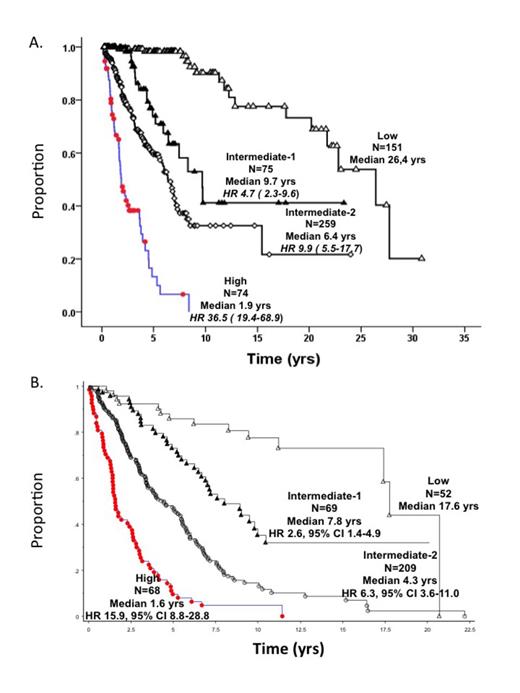Abstract
BACKGROUND. In primary myelofibrosis (PMF), survival from time of diagnosis is predicted by the international prognostic scoring system (IPSS), and from time of referral, by the dynamic IPSS (DIPSS) or DIPSS-plus. JAK2/CALR/MPL mutational status and presence and number of other prognostically-relevant mutations (ASXL1, SRSF2, EZH2, IDH1/2) provide IPSS/DIPSS-plus independent prognostic information. The objective in the current study was to revise IPSS, by including mutation-relevant prognostic information.
METHODS. The study included 986 PMF patients divided into learning (n=588) and validation (n=398) cohorts. Previously published methods were used to screen for mutations involving JAK2,MPL, CALR, EZH2, ASXL1, IDH1/2 and SRSF2. The clinical variables assessed were those previously identified as being prognostically-relevant by IPSS or DIPSS-plus. The prognostic model (MIPSS) was developed through a stepwise selection process, based on a z-test of the regression coefficients, and its relative quality was measured by means of the Akaike information criterion.
RESULTS. In the Italian learning cohort (n=588),median follow-up was 3.6years (95% CI, 0.03-30.8) for alive patients and 196 (33.3%) deaths and 67 leukemic transformations were documented. IPSS risk distribution was low in 26%, intermediate-1 in 30%, intermediate-2 in 24% and high in 20%. Mutational frequencies were approximately 63% for JAK2, 20% CALR, 6% MPL, 7% EZH2, 22% ASXL1, 2.5% IDH1/2 and 9% SRSF2. Constitutional symptoms were recorded in 28.6% of patients, splenomegaly 75% (18% >10cm from LCM) and grade 3 fibrosis 21%. Overall 252 patients were evaluable for karyotype and abnormalities were detected in 35%, including 9.5% unfavorable. Univariate analysis identified the following risk factors for inferior survival: age >60 years, constitutional symptoms, hemoglobin <100g/L, leukocytes >25x109/L, platelets <200x109/L, circulating blasts 1% or greater, splenomegaly >10cm, grade 3 fibrosis, unfavorable karyotype, triple-negativity for JAK2, MPL and CALR (TN), JAK2 or MPL mutation, and mutations in ASXL1, SRSF2, EZH2 or IDH1/2. In multivariable analysis, age >60 years, constitutional symptoms, hemoglobin <100g/L, platelets <200x109/L, TN, JAK2 or MPL mutation, ASXL1 and SRSF2 mutation remained significant; these variables were subsequently assigned the following HR-weighted adverse points: 1.5, 0.5, 0.5, 1.0, 1.5, 0.5, 0.5 and 0.5, respectively. Subsequently, four risk groups with no overlap in the 95% CI of their survival curves were delineated (Figure 1A): low (score 0-0.5); Intermediate-1 (score 1-1.5); Intermediate-2 (score 2-3.5); and high (score 4 or greater). The number of patients in each risk category, median survivals and HR and 95% CI values are included in figure 1A. Akaike information criterion indicated that MIPSS performed better than IPSS in predicting survival (1611.6 vs 1649.0). Leukemia-free survival was also predicted by high (p<0.01) and intermediate 1/2 (p<0.01) risk MIPSS.
In the Mayo Clinic validation cohort (n=398), median age 63 years; males 64%,median follow-up for alive patients was 7.5 years and 271 (68%) deaths and 51 (13%) leukemic transformations were documented. DIPSS-plus risk distribution was low in 13%, intermediate-1 18%, intermediate-2 37% and high 32%. Mutational frequencies were approximately 51% for JAK2, 30% CALR, 7.5% MPL, 5% EZH2, 36% ASXL1, 5.6% IDH1/2 and 13% SRSF2. MIPSS performed equally well in this cohort, as illustrated in figure 1B, which includes number of patients in each risk category with their median survival and HR and 95% CI values. Leukemia-free survival in the Mayo cohort was also predicted by high (p<0.01) and intermediate-2 (p=0.04) risk MIPSS. Patients in the Mayo cohort were fully annotated for karyotype, which was MIPSS-independent in its prognostic value for both overall (p<0.01) and leukemia-free (p<0.01) survival.
CONCLUSIONS. MIPSS addresses the mutation-relevant prognostic information gap in IPSS and performs equally well in the setting of patients seen at time of diagnosis or referral. Karyotype carries MIPSS-independent prognostic value that is recognized in an alternative GIPSS prognostic model (see accompanying ASH 2014 abstract), which complements MIPSS.
No relevant conflicts of interest to declare.
Author notes
Asterisk with author names denotes non-ASH members.


This feature is available to Subscribers Only
Sign In or Create an Account Close Modal